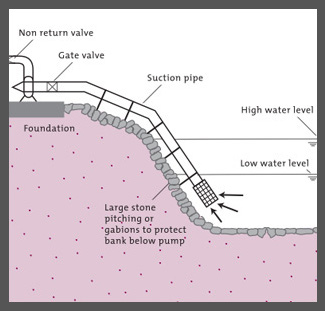Difference between revisions of "Water Portal / Rainwater Harvesting / Surface water / River-bottom intake"
From Akvopedia
< Water Portal | Rainwater Harvesting | Surface water
(→Suitable conditions) |
|||
| Line 4: | Line 4: | ||
==Suitable conditions== | ==Suitable conditions== | ||
| − | Rivers with little sediment and bed load. | + | * Rivers with little sediment and bed load. |
| + | * Where there is adequate flow. | ||
| + | * At a level that allows gravity supply to minimise pumping costs. | ||
| + | * Upstream of densely populated and farming areas to reduce silt inflow. | ||
| + | * Upstream of cattle watering places, washing places and sewer outlets (to eliminate pollution of the water). | ||
| + | * Upstream of bridges (to reduce velocity/turbulence). | ||
==Construction, operations and maintenance== | ==Construction, operations and maintenance== | ||
Revision as of 05:42, 18 April 2012
River-bottom or Tyrolean intakes for drinking-water systems are usually used in small rivers and streams where the sediment content and bed load transport are low. The water is abstracted through a screen over a canal (usually made of concrete and built into the river bed). The bars of the screen are laid in the direction of the current and sloping downwards, so that coarse material can- not enter. From the canal, water enters a sand trap and then may pass a valve and flow by gravity, or be pumped into the rest of the system.
Contents
Suitable conditions
- Rivers with little sediment and bed load.
- Where there is adequate flow.
- At a level that allows gravity supply to minimise pumping costs.
- Upstream of densely populated and farming areas to reduce silt inflow.
- Upstream of cattle watering places, washing places and sewer outlets (to eliminate pollution of the water).
- Upstream of bridges (to reduce velocity/turbulence).

